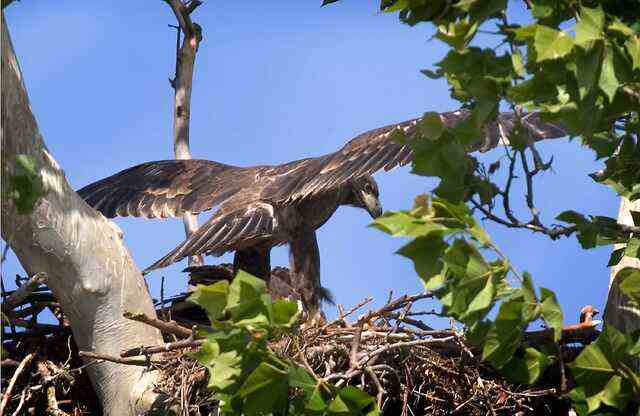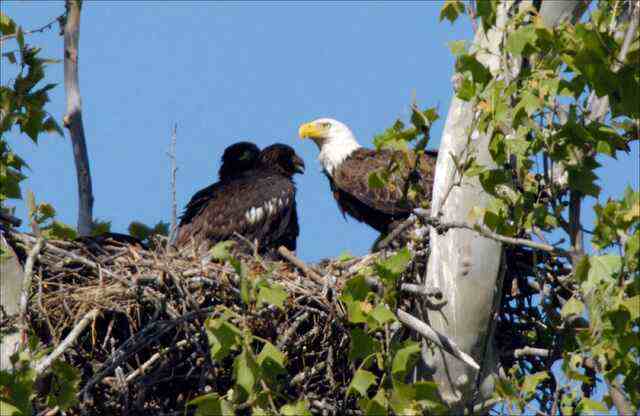In the vast wilderness, a delicate balance exists between the responsibilities of parenthood and the freedom bestowed upon eagles.
The question arises: How long can an eagle egg be left unattended before the parents resume their incubation duties?
This article explores eagle nesting habits, focusing on incubation and egg care.
By delving into typical incubation duration, factors influencing it, and fascinating behaviors as parents care for their eggs, we gain insight into the delicate dance of avian parenting.
Additionally, we examine dangers faced by unattended eggs and the impact of climate on incubation, revealing the adaptability of these remarkable creatures.
Table of Contents
- 1 Key Takeaways
- 2 How Long Can An Eagle Egg Be Left Unattended
- 3 Eagle Nesting Habits: A Brief Overview
- 4 The Importance of Incubation and Egg Care
- 5 Typical Duration of Egg Incubation
- 6 Factors That Can Affect Incubation Time
- 7 How Eagles Take Turns Incubating Eggs
- 8 The Role of Male and Female Eagles in Nesting
- 9 Potential Dangers and Risks for Unattended Eggs
- 10 Instances Where Eagles May Leave Eggs Unattended
- 11 The Impact of Climate and Weather on Incubation
- 12 Eagle Parenting: A Fascinating Look into Nesting Behavior
- 13 Frequently Asked Questions
- 13.1 How long can an eagle egg be left unattended before it becomes non-viable?
- 13.2 Are there any predators that specifically target unattended eagle eggs?
- 13.3 Do eagles ever intentionally leave their eggs unattended for extended periods of time?
- 13.4 Can eagle eggs survive extreme weather conditions if left unattended?
- 13.5 How do eagles locate and return to their nests after leaving their eggs unattended?
- 14 Conclusion
- 15 Author
Key Takeaways
- Incubation of eagle eggs is crucial for embryonic development and typically lasts 35 to 45 days.
- Both male and female eagles take turns incubating the eggs, ensuring a stable nest temperature and even heat distribution.
- Unattended eggs are vulnerable to predation and extreme weather conditions, which can pose significant risks to embryo survival.
- Instances of unattended eggs can occur due to temporary leaves by eagles, exposing the eggs to potential dangers and threats.
How Long Can An Eagle Egg Be Left Unattended
An eagle egg can be left unattended for brief periods during incubation. The incubation period typically lasts around 35 to 45 days, depending on the eagle species.
During this time, the parent eagles take turns to keep the egg warm and protected. Leaving the egg unattended for short intervals, such as when the parent switches shifts, is a natural behavior.
However, if the egg remains unattended for an extended period, it could risk cooling down and become nonviable.
The parental dedication in maintaining proper incubation conditions is crucial for the successful hatching of an eagle egg.
Eagle Nesting Habits: A Brief Overview
Eagle nesting habits encompass a variety of behaviors including nest construction, mate selection, copulation, fertilization and incubation, all of which contribute to the successful development of the eggs.
Eagles are known for their elaborate nest structures, which they build in high and secure locations such as cliffs or tall trees.
The nest construction process involves gathering materials such as sticks, grass, and moss, and carefully arranging them to create a sturdy platform.
Mate selection is a crucial step in the nesting process, as eagles form long-term monogamous pairs.
Once the eggs are laid, both parents take turns incubating them, ensuring that they are kept warm and protected.
The duration of incubation varies among eagle species, but typically lasts for around 35 to 45 days.
During this period, the parents diligently care for the eggs, regulating their temperature and protecting them from predators.
The importance of incubation and egg care cannot be overstated, as it directly influences the survival and development of the eaglets.
The Importance of Incubation and Egg Care
Avian reproductive success heavily relies on consistent incubation and attentive care of the developing embryo.
The importance of temperature control during incubation cannot be overstated, as slight deviations from the optimal range can negatively affect embryonic development.
Parental instincts play a crucial role in maintaining the appropriate temperature and humidity levels within the nest.
The four key aspects of incubation and egg care are:
- Maintaining a stable nest temperature is essential for proper embryonic development.
- Regularly turning the eggs ensures even heat distribution and prevents the embryo from sticking to the shell.
- Protecting the eggs from predators and adverse weather conditions is vital for the survival of the embryos.
- Providing adequate humidity levels within the nest helps prevent dehydration of the developing embryos.
Understanding the importance of these factors allows us to appreciate the challenges faced by eagles in ensuring the successful incubation of their eggs.
Transitioning into the subsequent section about the typical duration of egg incubation, it is essential to consider how these incubation practices contribute to the overall survival of the eagle species.
Typical Duration of Egg Incubation
One key aspect of avian reproductive success is the duration of egg incubation, which plays a crucial role in the survival of the developing embryos.
For eagles, the average incubation period can vary depending on the species, but it generally ranges from 34 to 45 days.
During this time, the eggs must be constantly maintained at an optimal temperature and humidity level to ensure proper embryonic development.
Interruptions in the incubation process, such as when the eggs are left unattended for extended periods, can have detrimental effects on the embryos.
It can lead to reduced hatching success, delayed development, or even embryo mortality.
Therefore, it is imperative for eagles to diligently attend to their eggs during the incubation period. Factors that can affect incubation time will be discussed in the subsequent section.
Factors That Can Affect Incubation Time
A crucial determinant of the duration of egg incubation is the consistency in maintaining optimal environmental conditions, as any interruptions or negligence during this period can have grave consequences on the viability and development of the embryos, potentially leading to a complete lack of progress or even their demise.
Several factors can influence the development of eagle eggs. Firstly, temperature plays a vital role, as deviations from the optimal range can disrupt embryonic growth.
Secondly, humidity levels need to be carefully regulated to prevent excessive moisture loss or buildup.
Additionally, the availability of sufficient oxygen within the nest is crucial for proper development.
Predators also pose a significant threat, as disturbances or attacks can cause stress and harm to the eggs.
Understanding these factors is essential to ensure successful incubation and hatching of eagle eggs.
Moving on, the subsequent section will explore how eagles take turns incubating eggs.
How Eagles Take Turns Incubating Eggs
To ensure the continuous and uninterrupted incubation of their eggs, eagles engage in a coordinated and synchronized process, where they take turns meticulously tending to the eggs in a seamless and harmonious manner.
This shared incubation pattern is crucial for successful eagle egg development. Both male and female eagles participate in the incubation process, with each taking responsibility for specific time intervals.
The duration of each incubation shift varies depending on various factors such as environmental conditions and the stage of egg development.
During their shifts, the incubating eagle maintains a constant temperature by covering the eggs with their feathers and adjusting their body position as needed.
This careful attention to the eggs ensures optimal development and hatching.
Transitioning to the subsequent section about the role of male and female eagles in nesting, it is important to understand their shared incubation patterns as they contribute to the overall success of the nesting process.
The Role of Male and Female Eagles in Nesting
Male and female eagles play distinct roles in the nesting process, with each contributing to the overall success and well-being of their offspring.
Male eagles are primarily responsible for the construction of the nest, using their powerful talons and beaks to gather branches and twigs.
They meticulously arrange these materials to create a sturdy structure that can support the weight of the eggs and provide protection from the elements.
Female eagles, on the other hand, are responsible for incubating the eggs.
They carefully regulate the temperature of the eggs by covering or uncovering them with their feathers, ensuring optimal conditions for the developing embryos.
This division of labor between the sexes ensures that the eggs receive the necessary care and attention.
However, if the eggs are left unattended for too long, they may become vulnerable to potential dangers and risks, such as predation or exposure to extreme weather conditions.
Potential Dangers and Risks for Unattended Eggs
Potential dangers and risks for eggs that are not attended to include exposure to predators and extreme weather conditions, placing the delicate embryos in a vulnerable position.
Unattended eagle eggs are susceptible to potential threats from predators such as raccoons, snakes, and other birds.
These predators can easily access the nest and prey upon the defenseless eggs, resulting in the loss of the developing embryos.
Additionally, extreme weather conditions, such as heavy rain or heatwaves, can negatively impact the viability of unattended eggs.
High temperatures can cause the eggs to overheat, leading to embryo mortality. Conversely, exposure to prolonged rain can increase the risk of egg chilling and hypothermia.
It is crucial for eagle parents to constantly attend their eggs to protect them from predator attacks and adverse weather conditions.
Instances where eagles may leave eggs unattended will be discussed in the subsequent section.
Instances Where Eagles May Leave Eggs Unattended
Instances when eagle parents take breaks from their incubation duties, the task of safeguarding their precious offspring, can be compared to a brief intermission in a grand theatrical performance, allowing the audience a moment to catch their breath before the show resumes.
During these intervals, eagle eggs are left unattended, exposing them to potential risks and dangers.
However, eagles have evolved certain behaviors and adaptations to minimize the risks associated with leaving the eggs unattended.
One reason why eagle parents may leave their eggs unattended is to engage in activities that are essential for their survival, such as hunting for food or defending their territory.
Another reason could be the need to stretch their wings and exercise their flight muscles, which is crucial for maintaining their physical fitness.
Additionally, there may be instances where the parents need to regulate their body temperature or seek relief from extreme weather conditions.
The following table illustrates some of the reasons why eagle parents may leave their eggs unattended:
| Reasons for Leaving Eggs Unattended |
|---|
| Hunting for food |
| Defending territory |
| Physical exercise |
| Regulating body temperature |
Understanding the reasons why eagle parents may leave their eggs unattended is essential to comprehend their natural behaviors and the challenges they face in ensuring the survival of their offspring.
Moving forward, it is crucial to explore the impact of climate and weather on incubation.
The Impact of Climate and Weather on Incubation
The environmental conditions during incubation play a crucial role in determining the success and viability of eagle eggs.
Climate change has been identified as a major factor that affects the incubation process.
Rising temperatures and unpredictable weather patterns can have detrimental effects on the development of eagle embryos.
Extreme temperatures, such as heatwaves or cold snaps, can disrupt the delicate balance required for successful incubation.
High temperatures can cause the eggs to overheat, leading to dehydration and reduced hatching rates.
Conversely, cold temperatures can slow down the development of embryos and increase the risk of mortality.
As climate change continues to alter ecosystems, it is important to monitor and understand the impact of these changes on eagle populations.
This knowledge can inform conservation efforts and help mitigate the negative effects of climate change on eagle reproduction.
Transitioning into the subsequent section about ‘eagle parenting: a fascinating look into nesting behavior’, the incubation period sets the stage for the intricate behaviors observed in eagle parenting.
Eagle Parenting: A Fascinating Look into Nesting Behavior
Nesting behavior in eagles involves intricate patterns of nest construction, maintenance, and shared responsibilities between the male and female partners.
Eagle nests, also known as eyries, are constructed on high cliffs or tall trees, providing a safe and sturdy platform for incubating eggs.
The construction process typically starts with the male collecting materials such as sticks, branches, and grass, which are then arranged by both partners to form a large nest.
The female lays 1-3 eggs, which are incubated for approximately 35-45 days.
During this period, both parents take turns incubating the eggs, with the male guarding the nest and hunting for food.
The eggs require a stable and warm environment for successful development, with the parents regulating the temperature by adjusting their body positions.
This synchronized effort in nest construction and egg incubation highlights the cooperative nature of eagle parenting and ensures the survival of their offspring.
Frequently Asked Questions
How long can an eagle egg be left unattended before it becomes non-viable?
Eagle eggs can be left unattended for short periods without adverse effects. However, prolonged exposure to extreme temperatures can render them non-viable. Implementing protective strategies, such as constructing nests in shaded areas, can mitigate temperature-related risks.
Are there any predators that specifically target unattended eagle eggs?
Predator-prey dynamics and nest defense strategies play a crucial role in the survival of eagle eggs. While unattended, various predators may target eagle eggs, making it necessary for the parents to employ effective nest defense strategies to ensure the eggs’ viability.
Do eagles ever intentionally leave their eggs unattended for extended periods of time?
Eagles do not intentionally leave their eggs unattended for extended periods of time. This behavior would negatively impact eagle egg survival and potentially have a detrimental effect on the overall eagle population.
Can eagle eggs survive extreme weather conditions if left unattended?
Eagle eggs possess remarkable resilience, akin to a fortress standing firm against the ravages of extreme weather conditions. However, the survival rate of unattended eggs in such climates impacts the dynamics of the eagle population.
How do eagles locate and return to their nests after leaving their eggs unattended?
The challenges in eagle nest construction and communication between eagle parents during egg incubation contribute to the ability of eagles to locate and return to their nests after leaving their eggs unattended.
Conclusion
In conclusion, eagle eggs require constant incubation and care to ensure successful hatching. The typical duration of egg incubation for eagles ranges from 34 to 45 days.
However, this period can be influenced by various factors such as temperature, weather conditions, and the behavior of the eagle parents.
Interestingly, research has shown that male and female eagles take turns incubating the eggs, with the male usually taking the night shift.
This cooperative nesting behavior is crucial for the survival and development of the eagle offspring.






